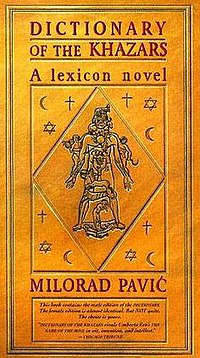|
Dictionary of the Khazars
Dictionary of the Khazars: A Lexicon Novel (Serbian Cyrillic: Хазарски речник, Hazarski rečnik) is the first novel by Serbian writer Milorad Pavić, published in 1984. Originally written in Serbian, the novel has been translated into many languages. It was first published in English by Knopf, New York City in 1988.[1] There is no easily discerned plot in the conventional sense, but the central question of the book (the mass religious conversion of the Khazar people) is based on a historical event generally dated to the last decades of the 8th century or the early 9th century when the Khazar royalty and nobility converted to Judaism, and part of the general population followed.[2] There are more or less three different significant time-periods that take place in the novel. The first period takes place between the 7th and 11th centuries and is mainly composed of the stories of the polemic, its representatives and the Khazars themselves. The second period takes place during the 17th century, and includes stories about the lives of the compilers of the in-universe Khazar Dictionary and their contemporaries. The third briefly takes place in the 1960s and 70s, but mostly in the 1980s, and includes stories of academics of areas that are in some way to do with the Khazars. There are also mentions of things that happened outside of these periods, such as the talk of primordial beings like Adam Ruhani and Adam Cadmon. Most of the characters and events described in the novel are entirely fictional, as is the culture ascribed to the Khazars in the book, which bears little resemblance to any literary or archeological evidence. The novel takes the form of three cross-referenced mini-encyclopedias, sometimes contradicting each other, each compiled from the sources of one of the major Abrahamic religions (Christianity, Islam, and Judaism). In his introduction to the work, Pavić wrote:
The book comes in two different editions, one "male" and one "female", which differ in only a critical passage in a single paragraph.[4] Pavić stated that the Khazars were a metaphor for a small people surviving in between great powers and great religions. In Yugoslavia, Serbs recognized their own fate; it was the same in Slovenia and elsewhere, a schoolbook on survival. The same in Hungary and Czechoslovakia, and on and on. A French critic said, 'We are all Khazars in the age of nuclear threat and poisoned environment.'[5] A ballet adaption of the Dictionary of the Khazars was staged at Madlenianum Opera and Theatre.[6] A play based on the novel has also been staged in the New Riga Theatre.[citation needed] In 2018, literary critic Matthias Friese argued that Pavić premised Dictionary of the Khazars on a strict dichotomy between lexical semantics and "social reality." According to Friese, in Dictionary of the Khazars, the deaths of the "dreamers" prior to meeting each other stemmed from Pavić's belief that semantic domains should be relegated to the world of "dreams" and not allowed to expand into the "flesh of reality." David Damrosch, in contrast, had previously contended that Pavić never articulated that particular premise and even explicitly collapsed the two into a totality.[7] CharactersCharacters from the 7th to 11th century
Characters from the 17th century
Characters from the 20th century
See alsoReferences
External links
|
||||||||||||||||||||||

